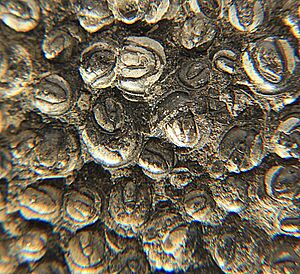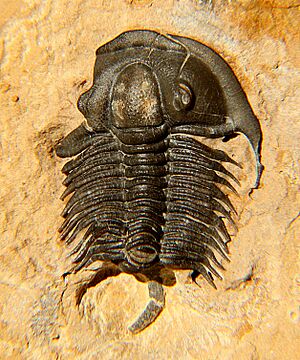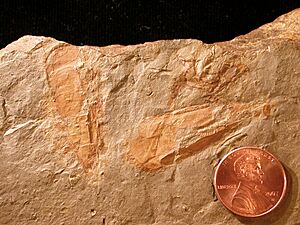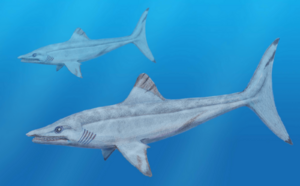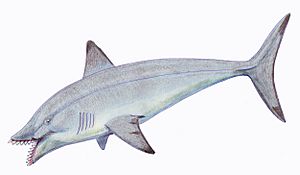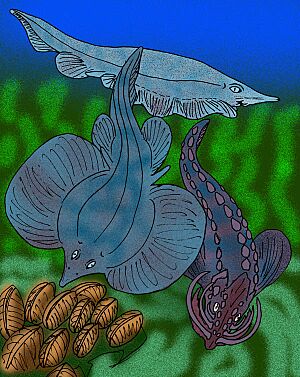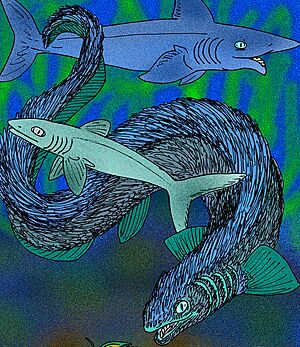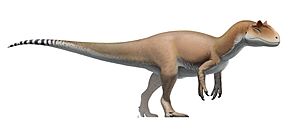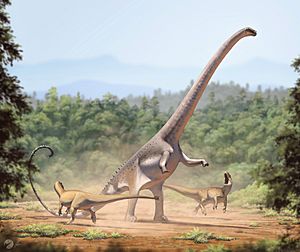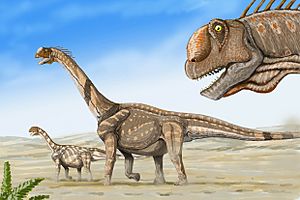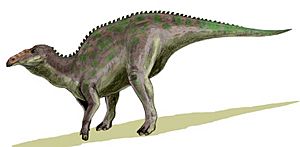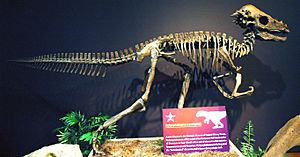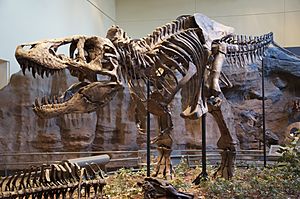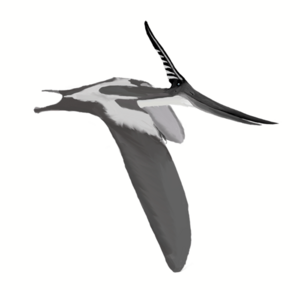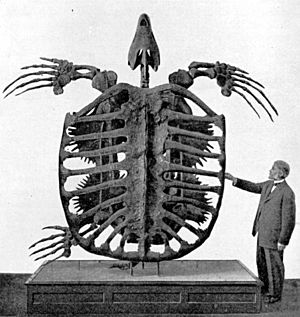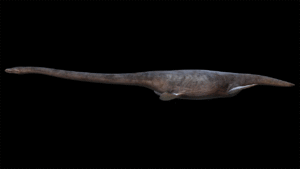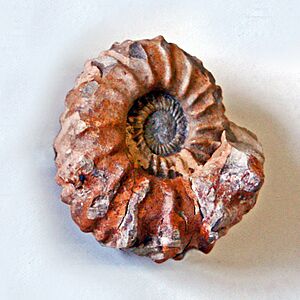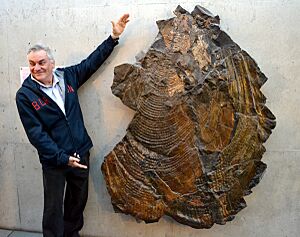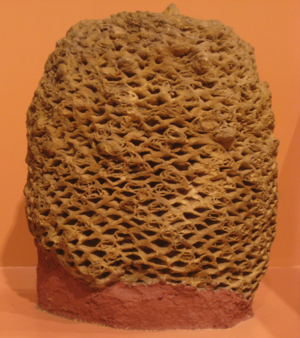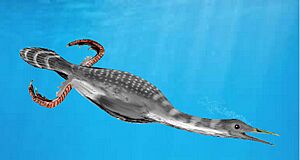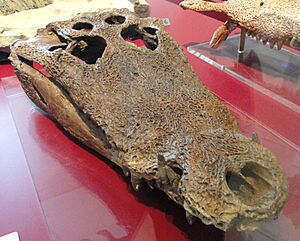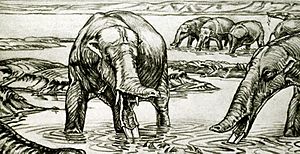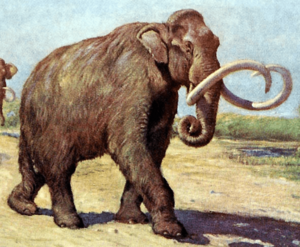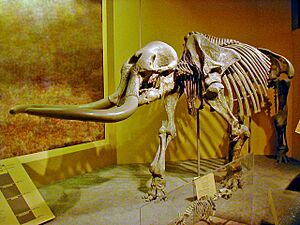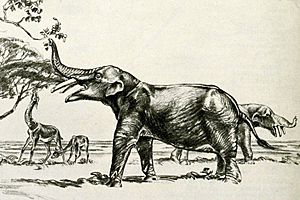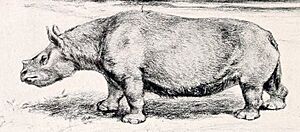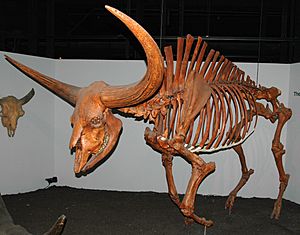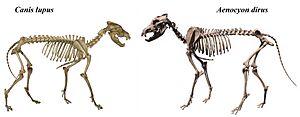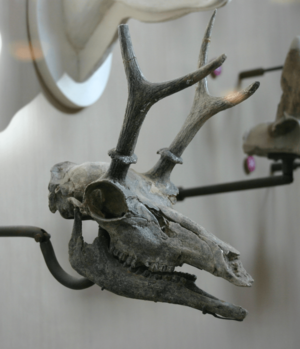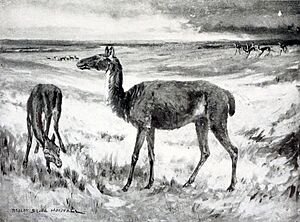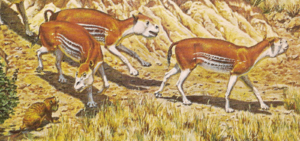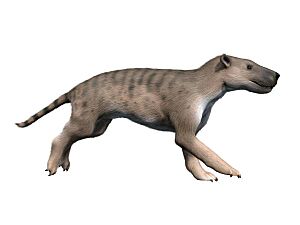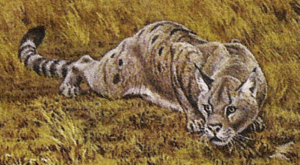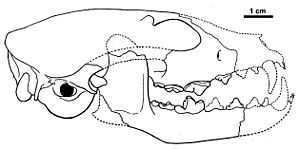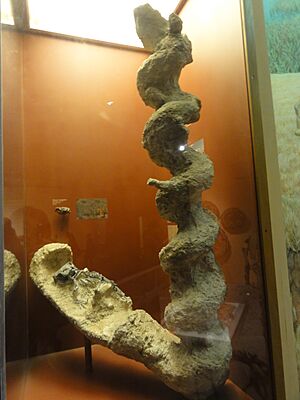List of the prehistoric life of South Dakota facts for kids
This article is about the amazing ancient creatures and plants whose fossils have been found in South Dakota. These fossils tell us a lot about what life was like millions of years ago in this area. From tiny sea creatures to giant dinosaurs and woolly mammoths, South Dakota has a rich history of prehistoric life!
Contents
Paleozoic Era: Ancient Sea Life
The Paleozoic Era was a very long time ago, from about 541 to 252 million years ago. During much of this time, parts of South Dakota were covered by shallow seas. This means many of the fossils found from this era are of sea creatures.
Tiny Trilobites and Other Sea Dwellers
Many of the fossils from the Paleozoic Era in South Dakota are from creatures called trilobites. These were ancient sea animals with hard, segmented bodies, a bit like modern-day crabs or insects. They are now extinct, meaning they no longer exist.
- †Agnostus was a small trilobite.
- †Crepicephalus was another type of trilobite found here.
- †Dikelocephalus was a larger trilobite.
- †Tricrepicephalus was also a trilobite.
Besides trilobites, other ancient sea animals lived in South Dakota:
- †Hyolitha were cone-shaped creatures that lived in shells. They might be related to brachiopods.
- †Cladodus was an early type of shark.
- †Caseodus was a relative of modern-day chimaeras, which are deep-sea fish.
- †Edestus was a very unusual shark with a spiral-shaped jaw.
- †Janassa was a ray-like cartilaginous fish.
- †Listracanthus was another cartilaginous fish.
Mesozoic Era: The Age of Dinosaurs
The Mesozoic Era, from about 252 to 66 million years ago, is often called the "Age of Dinosaurs." South Dakota has many famous dinosaur fossils, as well as other amazing creatures from this time.
Dinosaurs of South Dakota
Many different kinds of dinosaurs roamed South Dakota during the Mesozoic Era.
- †Allosaurus was a large, meat-eating dinosaur.
- †Apatosaurus was a huge, long-necked plant-eating dinosaur.
- †Barosaurus was another giant plant-eating dinosaur. South Dakota is where this dinosaur was first discovered!
- †Camarasaurus was a large, plant-eating sauropod dinosaur.
- †Dakotaraptor was a speedy, feathered predator. Its fossils were first found in South Dakota.
- †Diplodocus was one of the longest dinosaurs, known for its very long neck and tail.
- †Edmontonia was a heavily armored dinosaur.
- †Edmontosaurus was a common duck-billed dinosaur.
- †Gorgosaurus was a large, meat-eating tyrannosaur.
- †Hoplitosaurus was an armored dinosaur.
- †Hypsilophodon was a smaller, fast-running plant-eater.
- †Ornithomimus was a bird-like dinosaur that looked a bit like an ostrich.
- †Osmakasaurus was a duck-billed dinosaur first found in South Dakota.
- †Pachycephalosaurus was a dinosaur with a thick, dome-shaped skull. This type of dinosaur was first found in South Dakota.
- †Tatankaceratops was a horned dinosaur, also first found here.
- †Thescelosaurus was a small, plant-eating dinosaur.
- †Torosaurus was a large, horned dinosaur, similar to Triceratops.
- †Triceratops was a famous horned dinosaur.
- †Tyrannosaurus was one of the largest and most famous meat-eating dinosaurs.
Flying and Swimming Reptiles
The Mesozoic Era also had amazing reptiles that flew in the sky or swam in the seas.
- †Pteranodon was a large flying reptile, or pterosaur, with a long crest on its head.
- †Archelon was a giant sea turtle. Its fossils were first found in South Dakota.
- †Clidastes was a type of mosasaur, a large marine reptile.
- †Dolichorhynchops was a short-necked plesiosaur, a marine reptile with four flippers.
- †Elasmosaurus was a very long-necked plesiosaur.
- †Mosasaurus was a huge marine reptile, a top predator in the ancient seas. This type of mosasaur was first found in South Dakota.
- †Platecarpus was another type of mosasaur.
- †Styxosaurus was a long-necked plesiosaur, first found in South Dakota.
- †Tylosaurus was a very large and powerful mosasaur.
Other Mesozoic Life
- †Baculites were straight-shelled ammonites, a type of ancient mollusk.
- †Collignoniceras were coiled ammonites.
- †Inoceramus were very large marine clams.
- †Cycadeoidea were ancient plants that looked a bit like modern cycads or palms. Many types were first found in South Dakota.
- †Hesperornis was a toothed diving bird.
- †Leidyosuchus was an ancient alligator relative.
Cenozoic Era: The Age of Mammals
The Cenozoic Era began about 66 million years ago and continues to the present day. After the dinosaurs died out, mammals became the dominant large animals. South Dakota has many fossils from this era, showing a variety of ancient mammals.
Giant Mammals and Other Animals
- †Amebelodon was an ancient elephant relative with shovel-like tusks.
- †Mammuthus columbi, or the Columbian mammoth, was a huge elephant relative with long, curved tusks.
- †Stegomastodon was another elephant relative.
- †Eubelodon was also an ancient elephant relative.
- †Megacerops was a rhino-like mammal with a large horn on its snout.
- †Teleoceras was a short-legged rhinoceros.
- †Dinohyus was a giant pig-like animal.
- †Megalonyx was a giant ground sloth.
- †Bison latifrons was a very large, long-horned bison.
- †Canis dirus, the dire wolf, was a large wolf that lived alongside mammoths and saber-toothed cats.
- †Hemiauchenia was an ancient llama relative.
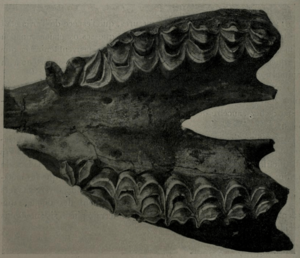
- †Cosoryx was an early pronghorn relative.
- †Poebrotherium was an early camel.
- †Merychyus was a type of oreodont, an extinct group of hoofed mammals.
Ancient Predators
- †Barbourofelis was a saber-toothed cat.
- †Dinictis was an early false saber-toothed cat.
- †Hyaenodon was a large, wolf-like predator.
- †Pseudaelurus was an early cat.
- †Leptocyon was an early dog.
Other Cenozoic Animals
- †Palaeocastor was an ancient beaver that dug spiral-shaped burrows.
- †Peltosaurus was an ancient lizard.
- †Stylemys was an ancient tortoise.


